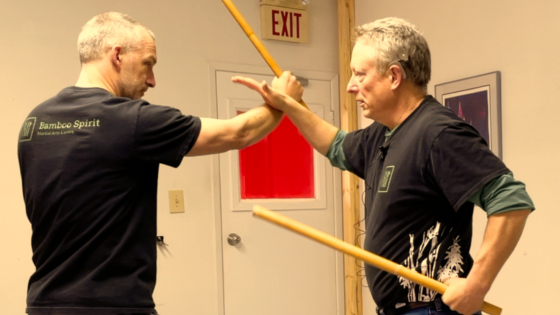5 Effective Ways To Practice Double Sinawali
Double sinawali comprises one of the four basic sinawalis taught in Modern Arnis (single, redonda and reverse) and, for a beginner, takes a fair bit of coordination.
If you are not able to view this video, click here.
There are several benefits to training any of the sinawali patterns.
- First, sinawali training promotes ambidexterity as both hands are involved.
- Secondly, sinawali drills develop eye-hand coordination, increasing the learning curve when delving into the applications.
- Thirdly, sinawali drills help to develop wrist, arm, and elbow strength.
- Lastly, done correctly, the sinawalis help develop an awareness of your centerline and core. This will develop power striking.
In my classes, there are five basic ways to practice double sinawali.
(1) Basic pattern: focus on the pattern without regard to lower body movement. This helps to develop some basic skills. It is enough for some folks to learn just the stick weaving pattern. For this reason, I do not add the footwork until they have competency with the upper body. For example, a common error is not completing the first stick of the double sinawali, as seen in this video.
(2) Add basic footwork: I did not demonstrate the footwork in the video above as I wanted to focus only on the weaving pattern.
The basic footwork is pretty simple:
Step forward with the same side as the first strike.
The first move on the right side = right foot forward.
The first move on the left side = left foot forward.
(3) Sideways movement: Once the basic footwork has been established, have both partners move sideways from one end of the room to the other end. This establishes the basic movement skill through space while engaging in double sinawali.
(4) Moving around the room: Once the partners get the sideways movement, challenge them further by having them move around the room randomly. This keeps both parties on their feet in terms of judging proper distance and range.
(5) Up and down: In this relatively challenging version, one partner performs double sinawali while going to their knees and then getting back up. Then the other partner does the same thing. Both partners should alternate. This results in a great leg workout while focusing on double sinawali.
There are other ways to practice double sinawali.
Regardless, (3), (4), and (5) are great ways to improve your mobility and agility while maintaining focus on the weaving pattern of double sinawali.
Over to the instructors, tell me how you have your students practice double sinawali.
Share this post:
- Click to share on Twitter (Opens in new window)
- Click to share on Facebook (Opens in new window)
- Click to share on LinkedIn (Opens in new window)
- Click to share on WhatsApp (Opens in new window)
- Click to share on Nextdoor (Opens in new window)
- Click to share on Pinterest (Opens in new window)
- Click to email a link to a friend (Opens in new window)
Tags In
Brian Johns
Related Posts
2 Comments
Leave a Reply Cancel reply
Categories
- Arnis/Kali/Eskrima (113)
- Book Review (8)
- DVD Reviews (3)
- Guest Post (4)
- Inspiration (24)
- Martial Arts (99)
- My story (92)
- Safety (14)
- Tips & tricks (6)
- Uncategorized (3)
- YouTube Videos (8)






[…] Ambidexterity: This is obvious. These drills develop ambidexterity, eye-hand coordination, power, speed, and strength. Your weak side will, in effect, copy the strong […]
[…] The late Professor Remy A. Presas was always fond of saying “you see, it is all the same!” when demonstrating the empty-hand application of stick concepts, such as single sinawali or other sinawali drills. […]